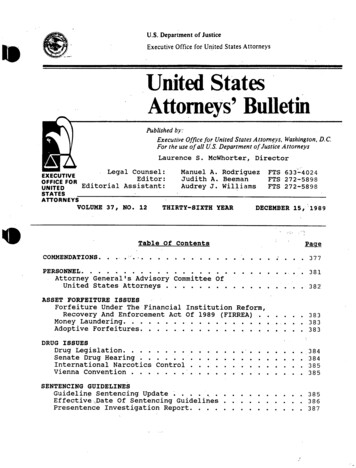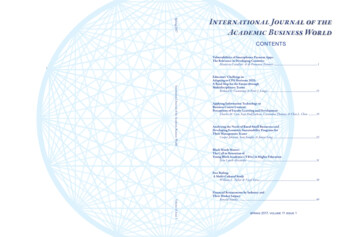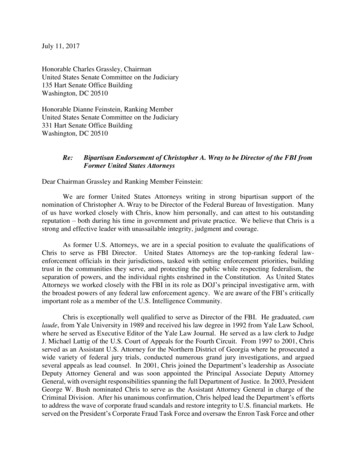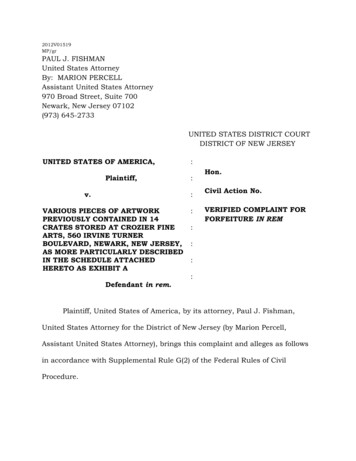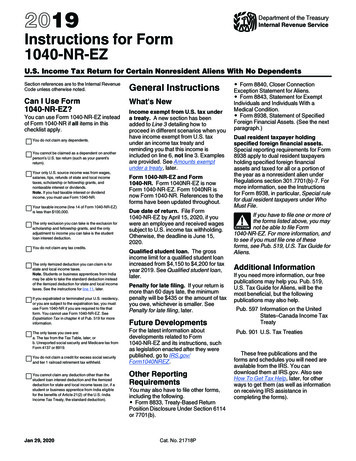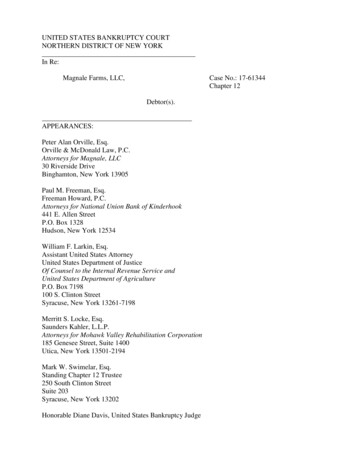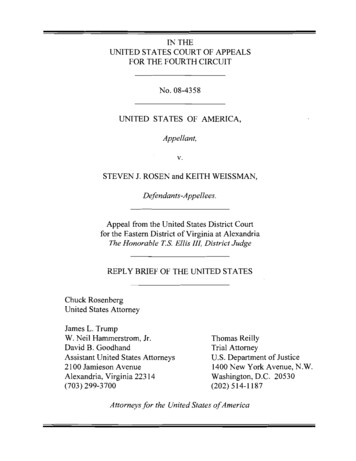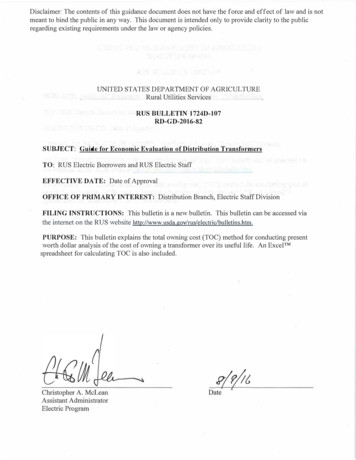
Transcription
Disclaimer: The contents of this guidance document does not have the force and effect of law and is notmeant to bind the public in any way. This document is intended only to provide clarity to the publicregarding existing requirements under the law or agency policies.UNITED STATES DEPARTMENT OF AGRICULTURERural Utilities ServicesRUS BULLETIN 1724D-107RD-GD-2016-82SUBJECT: Guide for Economic Evaluation of Distribution TransformersTO: RUS Electric Bmrnwers and RUS Electric StaffEFFECTIVE DATE: Date of ApprovalOFFICE OF PRIMARY INTEREST: Distribution Branch, Electric Staff DivisionFILING INSTRUCTIONS: This bulletin is a new b ulletin. This bulletin can be accessed viathe internet on the RUS website POSE: This bulletin explains the total owning cost (TOC) method for conducting present. worth dollar analysis of the cost of owning a transfo1mer over its useful life. An Excel spreadsheet for calculating TOC is also included.Christopher A. McLeanAssistant AdministratorElectric Program
RUS Bulletin 1724D-107Page 2TABLE OF CONTENTS1INTRODUCTION .42HISTORY . 43TERMS . 54TOTAL OWNING COST METHOD . 85ENERGY ESCALATION AND INFLATION . 96EXAMPLE . 10APPENDIX 1 . 13EQUIVALENT LEVEL COST FORMULA . 13APPENDIX 2 . 14INDEX:Total Ownership CostPurchase of Distribution NLNRECAPLRFTOCBid PriceCapacity FactorCooperative Research NetworkDemand ChargeDepartment of EnergyEnergy CostFixed Charge RateHours per YearWatts LL (transformer winding loss)Loss FactorWatts NL (no load loss)National Rural Electric Cooperative AssociationPeak LoadPeak Loss Responsibility FactorTotal Owning Cost
RUS Bulletin 1724D-107Page 3DEFINITIONSAverage Rate of Inflation – the estimated average rate of inflation per year for the life of thetransformerCapacity Factor (CF) - a measure of the average use of the transformer compared to itsmaximum possible usage, calculated by:capacity factor kwh sold per year through the transformer/(8760 x nameplate kva)Demand Charge (DC) - the levelized demand charge in /kw/year.Energy Cost (EC) - the levelized energy cost in /kwh to produce energy during the life of thetransformer.Energy Cost Increase per Year – the estimated average rate of increase in energy cost per yearduring the life of the transformer.Expected Transformer Life in Years – the estimated number of years the transformer will be inservice.First Year Peak (percent of nameplate kva) – the estimated peak load the transformer willexperience in the first year of installation.Hours per Year (HPY) - 8760 hours unless the analysis is for a special application or seasonaluse transformer, such as irrigation or pumping.Interest Rate for Borrowing Money – the estimated average rate of interest which the borrowerdetermines is being paid on loans.Levelized Cost – the present value of the total cost of owning and operating a piece of equipmentover its useful life converted to equal annual paymentsPeak Load Growth per Year – the estimated yearly rate of increase of the transformer’s peak loadduring its life.Peak Load Responsibility Factor – the proportion of system peak attributable to the load on atransformer at the time of the system peak. The peak load responsibility factor takes into accountthe fact that the peak load on a transformer does not usually occur at the same time as the systempeak. It is expressed as the ratio of the transformers peak load at the time of system peak to thepeak load on the transformer.
RUS Bulletin 1724D-107Page 41INTRODUCTIONThe purpose of this bulletin is to explain the total owning cost method (TOC) forconducting consistent and meaningful present worth dollar analysis of the cost of owninga transformer during its useful life using the TOC method. This method was devised inthe 1990s and continues to be widely used because of its simplicity. Transformers are amajor component of a distribution system, and the cost of buying them comprises a largepart of an annual equipment budget. TOC analysis can be used to compare the variousmanufacturers and their transformer designs on an equal basis and thus determine whichtransformers are the most economical to own and operate on a long-term basis.The total owning cost includes all the expenses associated with purchasing, operating andmaintaining a transformer over the life of the unit. While some expenses are relativelystable over the course of the transformer life like installation and removal costs, theborrower has little ability to control the level or timing of some expenses, such asmaintenance, or external factors, such as tax and interest rates. However, the borrowercan make decisions that balance the first cost of buying the transformer with the cost ofcore and copper losses, a significant portion of operating costs, to minimize ongoingcosts over the life of the unit.In general, a transformer with lower losses has a higher purchase price. While lowerlosses serve to reduce operating costs, a higher initial investment cost also results inhigher tax and interest costs. The transformer with the lowest total ownership cost isusually not the one with the lowest price or the lowest losses.As the cost of energy increases, the cost of losses becomes more significant, furtherjustifying the time and effort necessary to perform the TOC analysis.2HISTORYDistribution transformer efficiency, once a utility industry issue, is now regulated by thefederal government. The Energy Policy Act of 1975 prescribed conservation standardsfor various consumer products. The Energy Policy Act of 1992 directed the Departmentof Energy (DOE) to set minimum efficiency standards for distribution transformers.DOE has employed the Public Rule Making procedure to establish Final Rules for theminimum efficiency of distribution transformers. The Final Rule must be designed toachieve the maximum improvement in energy efficiency that is technologically feasibleand economically justified and also result in significant conservation of energy.The DOE standards apply to medium voltage liquid-immersed distribution transformersthat are commonly used by electric utilities, including rural electric cooperatives. Thestandards apply to newly manufactured transformers. They do not apply to transformersthat are already purchased or in service or those that are refurbished.The first DOE Final Rule, issued in 2007, set minimum efficiency standards to becomeeffective January 1, 2010. A review of a Final Rule must be performed every six years to
RUS Bulletin 1724D-107Page 5determine if standards should be changed. The DOE issued a Final Rule in 2013 tobecome effective January 1, 2016.NRECA has been an active participant in the DOE Ruling Makings for distributiontransformers. The DOE has recognized that cooperatives buy a significant number oftransformers and that those transformers may serve consumers with lower load factorsand thus have longer payback periods than experienced by other segments of the utilityindustry.It is important for rural electric cooperatives to carefully evaluate transformer purchasesand transformer operating practices. The economics of purchases and operation can beimproved by purchasing transformers evaluated under the principles of this Bulletin, asopposed to just purchasing transformers with minimum efficiency allowable asprescribed by the DOE standards.3TERMSThe following terms are found in the proceeding equations and are generally those for anelectric system. The data obtained would be applicable to all transformers on a system.However, when the purchases are for specific applications, such as transformers forirrigation systems, the hours of usage or load or the load factor will vary based on thatparticular application. The results obtained will apply to that application only. The dataused in the following calculations are general, and the results apply to all distributiontransformers as a group used in an electric system. This Bulletin was written to be used inconjunction with the CRN Loss Manual. For a greater understanding of the individualterms, use the Loss Manual as a guide.aFixed charge rate (FCR). The yearly income necessary to pay for a capitalinvestment. FCR is expressed as a percentage of capital investment. The FCRincludes interest, depreciation, taxes, insurance, operations and maintenance.Some typical values for the components of the FCR ns & MaintenanceFCR5.0%2.75%0.6%1.00%2.76%12.11%bBid Price (BP). The unit price at which a particular transformer manufactureroffers to sell transformers. This price should include transportation costs as wellas sales tax if applicable.cWatts NL (NL). The no load power loss in watts of a transformer at rated voltageand temperature. This is also called the transformer core loss. The no load lossesare furnished by the manufacturer for the transformer being considered for
RUS Bulletin 1724D-107Page 6purchase. In the calculations in this bulletin, the cost per watt for no load losses isrepresented by the symbol A.dWatts LL (LL). The electrical loss in watts due to windings of the transformer onlytaken at full rated load. This is also called the transformer winding loss. The loadlosses are furnished by the manufacturer for the transformer being considered forpurchase. In the calculations in this bulletin, the cost per watt for losses isrepresented by the symbol B. Note that the “Total Load Losses” is the sum of theNL and LL Losses.eHours Per Year (HPY). The number of hours per year the transformer will beenergized. In general, this value will be 8760 unless it is for a special applicationtransformer, such as an irrigation or pumping service.fDemand Charge (DC). A charge designed to reflect the maximum size offacilities required to deliver power, expressed in dollars per kilowatt-year. Forpower systems that generate, transmit and distribute power, it is power (kW) atpeak load from the generator, through the transmission and distribution systems tothe transformer. For systems that purchase power and distribute it, the annualvalue for DC is the monthly demand charge including escalation, multiplied by 12to give /kw-year. DC′ will be used in both the A and B value calculations andindicates a levelized value that includes escalation and inflation. A detaileddiscussion of calculating DC′ will follow in the next section.gEnergy Cost (EC). The cost, in dollars per kWh, to produce energy during the lifeof the transformer, including escalation, estimated inflation and other factorswhich affect energy cost. EC′ will be used in both the A and B value and indicatesa levelized value that includes escalation and inflation. A detailed discussion ofcalculating EC′ will follow in the next section.hPeak Load (PL). The uniform equivalent maximum load on a transformer duringthe period of the evaluation. It is an approximation of actual transformer annualpeak load since it assumes that the annual peak load increases at a constantpercentage rate. This value is levelized so it can be used in the calculations for theentire life of the transformer.*PL2 is used in the calculations, instead of PL since PL2 is used in the basicformula for A and BThe following is the approximation for calculating the PL2 value for the life of thetransformer:(PLI )2 [(1 𝑖𝑖)𝑛𝑛 (1 𝑔𝑔)2𝑛𝑛 ](PL) CRF𝑛𝑛(1 𝑖𝑖)𝑛𝑛 [(1 𝑖𝑖) (1 𝑔𝑔)2 ]2PL I the anticipated peak load during the first year of installation expressed as adecimal equivalent
RUS Bulletin 1724D-107Page 7g the decimal equivalent of the estimated annual percentage increase in peakload during the life of the transformeri the average rate of interest which the borrower determines is being paid on theloansn the number of years which the transformer will be in servicep the estimated average increase in energy cost per annum during the useful lifeof the transformerCRF n the capital recovery factor used to levelize the total present worthevaluation. It converts the sum into a uniform annual series whose total presentworth is identical to the actual present worth. It is defined as follows:iCRF𝑛𝑛 𝑖𝑖(1 𝑖𝑖)𝑛𝑛(1 𝑖𝑖)𝑛𝑛 1Peak Loss Responsibility Factor (RF). A factor that adjusts for differencesbetween the peak load on a transformer and peak load on the distribution system,which typically do not occur at the same time. The transformer′s contribution tothe system peak load is usually only a fraction of the load on the transformer atits peak load, so it is therefore most often less than one (1). Since losses varywith the square of the load, the peak loss responsibility factor is the square of thepeak load responsibility factor.The following is the equation for estimating the peak load responsibility �𝑇𝑇𝑇𝑇𝑇𝑇𝑇𝑇𝑇𝑇𝑇 𝑙𝑙𝑙𝑙𝑙𝑙𝑙𝑙 𝑎𝑎𝑎𝑎 𝑡𝑡𝑡𝑡𝑡𝑡𝑡𝑡 𝑜𝑜𝑜𝑜 𝑠𝑠𝑠𝑠𝑠𝑠𝑠𝑠𝑠𝑠𝑠𝑠 𝑝𝑝𝑝𝑝𝑝𝑝𝑝𝑝 ��𝑇𝑇𝑇𝑇𝑇𝑇𝑇𝑇𝑇 𝑝𝑝𝑝𝑝𝑝𝑝𝑝𝑝 𝑙𝑙𝑙𝑙𝑙𝑙𝑙𝑙Then to get the peak loss responsibility factor, square the previous 𝑇𝑇𝑇𝑇𝑇𝑇𝑇𝑇𝑇𝑇𝑇𝑇 𝑙𝑙𝑙𝑙𝑙𝑙𝑙𝑙 𝑎𝑎𝑎𝑎 𝑡𝑡𝑡𝑡𝑡𝑡𝑡𝑡 𝑜𝑜𝑜𝑜 𝑠𝑠𝑠𝑠𝑠𝑠𝑠𝑠𝑠𝑠𝑠𝑠 𝑝𝑝𝑝𝑝𝑝𝑝𝑝𝑝 2RF ��𝑇𝑇𝑇𝑇𝑇𝑇𝑇𝑇𝑇 𝑝𝑝𝑝𝑝𝑝𝑝𝑝𝑝 𝑙𝑙𝑙𝑙𝑙𝑙𝑙𝑙Loss Factor (LSF). The ratio of the average transformer losses to the peaktransformer losses during a specific period of time. If the system (or individualtransformer) load factor is known, the loss factor can be calculated for the systemof transformers or the individual transformer as follows:𝑘𝑘𝑘𝑘ℎ 𝑝𝑝𝑝𝑝𝑝𝑝 𝑦𝑦𝑦𝑦𝑦𝑦𝑦𝑦Load Factor 8760 𝑝𝑝𝑝𝑝𝑝𝑝𝑝𝑝 𝑘𝑘𝑘𝑘Loss Factor 0.2 (𝐿𝐿𝐿𝐿𝐿𝐿𝐿𝐿 𝐹𝐹𝐹𝐹𝐹𝐹𝐹𝐹𝐹𝐹𝐹𝐹) 0.8 (𝐿𝐿𝐿𝐿𝐿𝐿𝐿𝐿 𝐹𝐹𝐹𝐹𝐹𝐹𝐹𝐹𝐹𝐹𝐹𝐹)2
RUS Bulletin 1724D-107Page 84TOTAL OWNING COST METHODThe total owning cost of a transformer is the sum of the first cost, or cost of purchasingthe transformer, plus the cost of losses. Transformers experience two types of losses,core losses and winding losses. The core losses are due to the fields that magnetize thetransformer core and are always present regardless of the transformer loading, which iswhy these losses are referred to as no-load losses. The winding losses are due to thenormal I2R losses in the windings on the transformer. These vary with the square of theload on the transformer, which is why these are referred to as load losses.A transformer bid typically specifies the bid price, no-load losses in watts, and loadlosses in watts. These loss values should be provided by the manufacturer and should notbe exceeded by test values of the transformers delivered. A basic method of transformerevaluation is to assign a cost per watt in /watt for each the no-load and load losses. Thecost per watt for no-load losses is the transformer design A value, and the cost per wattfor load losses is the transformer design B value. The A and B values help to determinethe total ownership cost of the losses on any given transformer with a load loss and noload loss value.The Total Ownership Cost method is based on the levelized costs associated with owningthe transformer, including the cost of the transformer, losses, inflation, increases inenergy costs and increases in demand charges, if applicable. The levelized cost is thepresent value of these costs converted to equal annual payments.The levelized cost is not an average. Using energy as the example, with energy costsrising, the levelized energy charge is higher than the energy cost in the early years of theproject and lower than the energy cost in the later years.The total ownership cost of a transformer is calculated:TOC Bid Price (A NL B LL)Where:A B DC′ (HPY EC′ )(FCR 1000)in /watt PL2 RF DC′ (PL2 HPY LSF EC′ )(FCR 1000)in /wattAs shown in the following sections, the transformer with the lowest total ownership costis not necessarily the one with the lowest purchase price. The utility typically providesthe manufacturer with the A and B values to be used in the TOC evaluation for use intransformer design.
RUS Bulletin 1724D-107Page 95ENERGY ESCALATION AND INFLATIONAccounting for inflation in economic studies is a difficult and complex issue. Thepurpose of this section is not to provide a comprehensive analysis of the subject butrather to provide some general guidelines.One method of handling inflation is to increase future variable costs, such as the costs oflosses, by the percentage represented by the general inflation rate. Since the calculationsfor A and B do not have any provisions for costs that increase over the years, anequivalent level cost that takes into account future cost increases should be used. This issometimes referred to as the levelized value. The following equation derives such a valueand can be used to adjust for inflation (See Appendix 1 for derivation):A′ A X Where:(1 X 𝑛𝑛 ) CRF𝑛𝑛(1 X)𝑋𝑋 inflation adjustment (1 𝑟𝑟)(1 𝑖𝑖)for r iA′ the cost adjusted for inflationA the base cost before inflationn the number of years in the inflation period, usually the life of the transformeri the average rate of interest being paid on loansr the average year over year rate of inflation over the life of the transformerWhile this method reflects increases in future costs, it fails to take into account that thevalue of money decreases with inflation. Another method of handling inflation is toassume that the increase of costs in the future will be balanced out by the decrease in thevalue of money, thus allowing us to ignore inflation all together. The problem with thisapproach is that the assumption does not always hold true, because costs of certain itemsmay increase faster than the inflation rate.A third, more realistic method of treating inflation is to compensate both for the increasein costs associated with the generation and transmission of electric power and for thedecrease in the value of the dollar associated with the generally prevailing inflation rate.This compensation can be accomplished calculating an equivalent inflation rate (r′) thatcan be used in the original equation for X.𝑟𝑟 ′ (1 𝑃𝑃)(1 𝑖𝑖𝑖𝑖)Where: 1 for P igr′ The equivalent inflation rate
RUS Bulletin 1724D-107Page 10P the rate of increase in costs per kwh associated with power generation andtransmission expressed as a decimalig the inflation rate for the economy as a whole expressed as a decimalNow the equivalent inflation rate can be used in the original equation for X as follows:𝑋𝑋 (1 𝑟𝑟′)(1 𝑖𝑖)for r′ iIf the equivalent inflation rate r′ and the interest rate i are the same, the cost adjusted forinflation and the base cost will be the same as was described in Method 2.6EXAMPLEThe following example illustrates the process of determining the total ownership cost fora 50 kVA pad mounted distribution transformer including calculating the levelized valuesfor peak loading and energy costs.Bid Price 3,000NL 94 Watts (from manufacturers 50 kva transformer)LL 464 Watts (from manufacturers 50 kva transformer)DC 120/kw-Year (the initial demand cost calculated by the borrower)DC′ levelized demand cost, to be calculatedEC 0.05/kwh (the initial energy cost)EC′ levelized energy cost, to be calculatedPL I 80% (the initial peak load)PL levelized annual peak load, to be calculatedRF .81 Peak Loss Responsibility Factor (assuming a peak load responsibility factor of.9)LSF .3 Loss FactorFCR 14.2%Assumptions:50 kva transformer30 year lifespan
RUS Bulletin 1724D-107Page 11Initial peak load: 80% of rating or .8Load Growth (g) 1%/year or .01Interest Rate (i) 5%/year or .05Energy Escalation Rate (p) 3%/year or .03General Inflation Rate (ig) 2.5%/year or .025CRF30 . 05(1 .05)30. 05(4.32) .06530(1 .05) 1 (4.32) 1(.8)2 [(1 .05)30 (1 .01)60 ] .065(PL) (1 .05)30 [(1 .05) (1 .01)2 ]2(PL)2 . 64 [4.32 1.82] . 0654.32 [1.05 1.02](PL)2 12.34 .065 .8021To calculate the levelized demand and energy costs:𝑟𝑟 ′ 𝑟𝑟 ′ 𝑋𝑋 𝑋𝑋 (1 𝑃𝑃)(1 𝑖𝑖𝑖𝑖) 1 for P ig(1 .03) 1 .0049(1 .025)(1 𝑟𝑟′)(1 𝑖𝑖)for r′ i(1 .0049) .957(1 .05)DC′ DC X (1 X 𝑛𝑛 ) CRF𝑛𝑛(1 X)DC′ 120 .957 (1 . 95730 ) .065(1 .957)
RUS Bulletin 1724D-107Page 12DC′ 120 16.3 .065 127.30 per kw-yearEC′ EC X (1 X 𝑛𝑛 ) CRF𝑛𝑛(1 X)(1 . 95730 )EC 0.05 .957 .065(1 .957)′EC′ 0.05 16.3 .065 0.053 per kwhTo calculate the A and B values:A A DC′ (HPY EC′ )(FCR 1000)in /watt127.30 (8760 0.053)(.142 1000)in /wattA 4.169 in /wattB B PL2 RF DC′ (PL2 HPY LSF EC′ )(FCR 1000)in /watt(.8021 .81 127.30) (.8021 8760 .3 .053)(.142 1000)in /wattB 1.37 in /wattTo calculate the transformer’s total ownership cost:TOC Bid Price (A NL B LL)TOC 3000 ( 4.169/W 94 W 1.37/W 464 W)TOC 4027.56The total ownership cost should be calculated for each transformer under consideration.The transformer with the lowest total ownership cost would be the most economicallifetime investment. A spreadsheet has been included in Appendix 2 to assist with thecalculations.
RUS Bulletin 1724D-107Page 13APPENDIX 1EQUIVALENT LEVEL COST FORMULAThe following illustration provides a derivation of Equation 9, which is used to adjust costevaluations for inflation. Equation 9 will produce a level cost (or energy charge rate) that willyield the same total present worth value as a cost (or energy charge rate) that is increasing at rpercent per year.The present worth of a cost increasing at r percent per year is: (1 r) (1 r) 2 (1 r)n PW A * n (1 i) (1 i) 2 (1 i) where:i the time value of moneyr the rate of inflationA the cost before inflationPW the present worthn the time period in yearsIf we let 1 r X 1 i then:PW A * X * (1 X X 2 X n 1 )Algebraic manipulation yields the following: 1 X n PW A * X 1 X Multiplying the above by the capital recovery factor to get an equivalent level yearly cost yields: 1 X n i(1 i)n A' A * X n 1 X (1 i) 1
RUS Bulletin 1724D-107Page 14APPENDIX 2ECONOMIC EVALUATION OF DISTRIBUTION TRANSFORMERSThis spreadsheet shows a method for calculating the levelized energy cost of producing energyover the life of the transformer in /kwh. The program uses typical values as a starting point. Inthe electronic form of this bulletin, the evaluation formula will be updated as new data is entered.Demand ChargeEnergy ChargeFixed Charge RateHours per yearCapacity FactorPeak Load Responsibility FactorEnergy Cost Increase per YearAverage InflationInterest Rate for Borrowing MoneyFirst Year Peak (%of nameplate Kva)Peak Load Growth per YearExpected Transformer Life in YearsData: 120.00 0.0514.2%87600.50.93.0%2.5%5.0%80%1.00%30Formula Price A* core loss B* coil lossA B Loss Factor (LSF)PL 2equivalent inflation rate r'Inflation adjustment (X)Inflation adjustment factorlevelized inflation adjusted factorCRFnDC'EC' 4.169 05 127.30 0.0530An electronic Excel copy of this spreadsheet is available from the NRECA T&D System PlanningSubcommittee Chair and the Staff Director of the RUS Electrical Engineering Branch.
losses are furnished by the manufacturer for the transformer being considered for purchase. In the calculations in this bulletin, the cost per watt for losses is represented by the symbol B. Note that the "Total Load Losses" is the sum of the NL and LL Losses. e Hours Per Year (HPY). The number of hours per year the transformer will be




